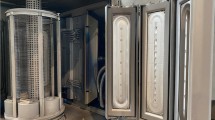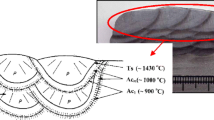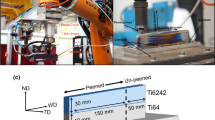Abstract
The effect of the welding arc current (47, 57, and 67 A) on the structure and properties of the deposited samples obtained by electric arc robotic deposition has been studied. Welding wire Sv-AK5 (ER4043) of the Al-Si system was used as a filler material. The weld deposition was carried out on a substrate in the form of a plate 6 mm thick made of AMg6 alloy (Al–Mg system). In the process of surfacing, a typical two-phase structure of a hypoeutectic composition is formed in the samples, which is characteristic of alloys of the Al‒Si system with a silicon content of 5%. A trend to the enlargement of the structure in the direction from the substrate is observed along height of the deposited layers, which is associated with the accumulation of heat in the layers deposited along the height. With an increase in the welding arc current, dendrites based on α-Al and eutectic Si crystals are refined, while their density increases and microhardness decreases. The increase in density is due to a decrease in the proportion and size of gas pores and the refinement of structural components. The decrease in microhardness is associated with an increase in the proportion of the soft phase (α-Al dendrites) and a decrease in the number hard eutectic silicon crystals. The average content of silicon in the samples deposited in three modes is in the range of 5.46–5.91%, which corresponds to the chemical composition of the welding wire Sv-AK5 (ER4043). An increase in the welding arc current facilitates a growth of tensile strength and a slight decrease in the conditional yield strength and relative elongation. The patterns of the change in the mechanical properties of the deposited samples are due to the specifics of the formation of the cast structure of the deposited layers under conditions of directional solidification in the direction away from the substrate.








Similar content being viewed by others
Notes
The studies were carried out at the Laboratory of Electrophysical Technologies of the Center of Cast Technologies of the Samara State Technical University. The laboratory operates the equipment provided by an industrial partner, OOO Welding Group Samara (Samara, Russia).
The program was provided by an industrial partner, OOO SPRUT-Technology (Naberezhnye Chelny, Russia).
REFERENCES
Huang, S., Liu, P., Mokasdar, A., and Hou, L., Additive manufacturing and its societal impact: A literature review, Int. J. Adv. Manuf. Technol., 2013, vol. 67, nos. 5–6, pp. 1191–1203.
Petrovic, V., Gonzales, J., Ferrando, O., Gordillo, J., Puchades, J., and Grinan, L., Additive layered manufacturing: sectors of industrial applications shown through case studies, Int. J. Prod. Res., 2011, vol. 49, no. 4, pp. 1061–1079.
Ford, S.L.N., Additive manufacturing technology: potential implications for U.S. manufacturing competitiveness, Int. J. Commer. Econ., 2014. https://usitc.gov/publications/332/journals/vol_vi_article4_additive_manufacturing_technology.pdf. Accessed June 6, 2020.
Gebhardt, A. and Hotter, J.-S., Additive Manufacturing: 3D Printing for Prototyping and Manufacturing, Munich: Carl Hanser Verlag, 2016.
Zhukov, V.V., Grigorenko, G.M., and Shapovalov, V.A., Additive manufacturing of metal products (review), Paton Weld. J., 2016, nos. 5–6, pp. 137–142.
Herzog, D., Seyda, V., Wycisk, E., and Emmelmann, C., Additive manufacturing of metals, Acta Mater., 2016, no. 117, pp. 371–392.
DebRoy, T., Wei, H.L., Zuback, J.S., Mukherjee, T., Elmer, J.W., Milewski, J.O., Beese, A.M., Wilson-Heid, A., De, A., and Zhang, W., Additive manufacturing of metallic components—process, structure and properties, Prog. Mater. Sci., 2018, vol. 92, pp. 112–224.
Zhatkin, S.S., Nikitin, K.V., Deev, V.B., Pankratov, S.S., and Dunaev, D.A., Application of electric arc surfacing in the manufacturing of three-dimensional steel products, Steel Transl., 2020, vol. 50, no. 6, pp. 381–386.
Kruth, J.-P., Mercelis, P., Van Vaerenbergh, J., Froyen, L., and Rombouts, M., Binding mechanisms in selective laser sintering and selective laser melting, Rapid Prototyping J., 2005, vol. 11, no. 1, pp. 26–36.
Alberti, E.A., Silva, L.J., and D’Oliveira, A.S., Additive manufacturing: the role of welding in this window of opportunity, Weld. Int., 2016, vol. 30, no. 6, pp. 413–422.
Knezović, N. and Topić, A., Wire and arc additive manufacturing (WAAM): A new advance in manufacturing, in New Technologies, Development and Application, NT 2018, Lecture Notes in Networks and Systems, Karabegović, I., Ed., Cham: Springer, 2018, vol. 42, pp. 65–71.
Williams, S.W., Martina, F., Addison, A.C., Ding, J., Pardal, G., and Colegrove, P., Wire + Arc additive manufacturing, Mater. Sci. Technol., 2016, vol. 32, no. 7, pp. 641–647.
Ding, D., Pan, Z., van Duin, S., Li, H., and Shen, C., Fabricating superior NiAl bronze components through wire arc additive manufacturing, Materials, 2016, vol. 9, no. 652, pp. 1–12.
Cunningham, C.R., Flynn, J.M., Shokrani, A., Dhokia, V., and Newman, S.T., Invited review article: Strategies and processes for high quality wire arc additive manufacturing, Addit. Manuf., 2018, vol. 22, pp. 672–686.
Nagamatsua, H., Sasaharaa, H., Mitsutakeb, Y., and Hamamoto, T., Development of a cooperative system for wire and arc additive manufacturing and machining, Addit. Manuf., 2020, vol. 31, pp. 1–11.
Wang, X., Fan, D., Huang, J., and Huang, Y., Numerical simulation of arc plasma and weld pool in double electrodes tungsten inert gas welding, Int. J. Heat Mass Transfer, 2015, vol. 85, pp. 924–934.
Ding, D., Pan, Z., Cuiuri, D., and Li, H., Wire-feed additive manufacturing of metal components: technologies, developments and future interests, Int. J. Adv. Manuf. Technol., 2015, vol. 81, pp. 465–481.
Baufeld, B., Biest, O.V., and Gault, R., Additive manufacturing of Ti–6Al–4V components by shaped metal deposition: Microstructure and mechanical properties, Mater. Des., 2010, vol. 31, pp. 106–111.
Wang, F., Williams, S., Colegrove, P., and Antonysamy, A.A., Microstructure and mechanical properties of wire and arc additive manufactured Ti–6Al–4V, Metall. Mater. Trans. A, 2012, vol. 44, no. 2, pp. 968–977.
Clark, D., Bache, M.R., and Whittaker, M.T., Shaped metal deposition of a nickel alloy for aero engine applications, J. Mater. Process. Technol., 2008, vol. 203, nos. 1–3, pp. 439–448.
Peleshenko, S., Korzhyk, V., Voitenko, O., Khaskin, V., and Tkachuk, V., Analysis of the current state of additive welding technologies for manufacturing volume metallic products (review), East.-Eur. J. Enterp. Technol., 2017, no. 3/1 (87), pp. 42–52.
Panchenko, O.V., Zhabrev, L.A., Kurushkin, D.V., and Popovich, A.A., Macrostructure and mechanical properties of Al–Si, Al–Mg–Si, Al–Mg–Mn alloys obtained by electric arc additive cultivation, Metalloved. Term. Obrab. Met., 2018, no. 11, pp. 63–69.
Korzhyk, V.N., Khaskin, V.Yu., Grinyuk, A.A., Babich, A.A., Sutkovoi, A.D., and Olyinychenko, T.V., The study of the technological characteristics of hybrid plasma arc welding of aluminum alloys, Sci. Eur., 2016, no. 6, pp. 45–51.
Wang, Y., Konovalov, S.V., Chen, X., Ivanov, Y., Singh, R.A., Jayalakshmi, S., and Pan, X., Microstructure and mechanical properties of Cu–Al alloy deposited by additive manufacturing, Mater. Highlights, 2021, vol. 2, no. 3, pp. 46–51.
Kirichek, A.V., Fedonin, O.N., Solov’ev, D.L., Zhirkov, A.A., Khandozhko, A.V., and Smolentsev, E.V., Additive-subtractive technologies—effective transition to innovation production, Vestn. Bryansk. Gos. Tekh. Univ., 2019, no. 8, pp. 4–10.
Strong, D., Kay, M., Conner, B., Wakefield, Th., and Manogharan, G., Hybrid manufacturing—integrating traditional manufacturers with additive manufacturing (AM) supply chain, Addit. Manuf., 2018, no. 21, pp. 159–173.
Funding
This study was financially supported by the RF Ministry of Education and Science as part of the state assignment no. 0778-2020-0005.
Author information
Authors and Affiliations
Corresponding author
Ethics declarations
The authors declare that they have no conflicts of interest.
Additional information
Translated by M. Shmatikov
About this article
Cite this article
Nikitin, K.V., Dunaev, D.A., Zhatkin, S.S. et al. Studies of the Structure and Properties of Weld Deposits of the Sv-AK5 Filler Wire in Robotized Deposit Welding. Russ. J. Non-ferrous Metals 63, 537–543 (2022). https://doi.org/10.3103/S1067821222050066
Received:
Revised:
Accepted:
Published:
Issue Date:
DOI: https://doi.org/10.3103/S1067821222050066




